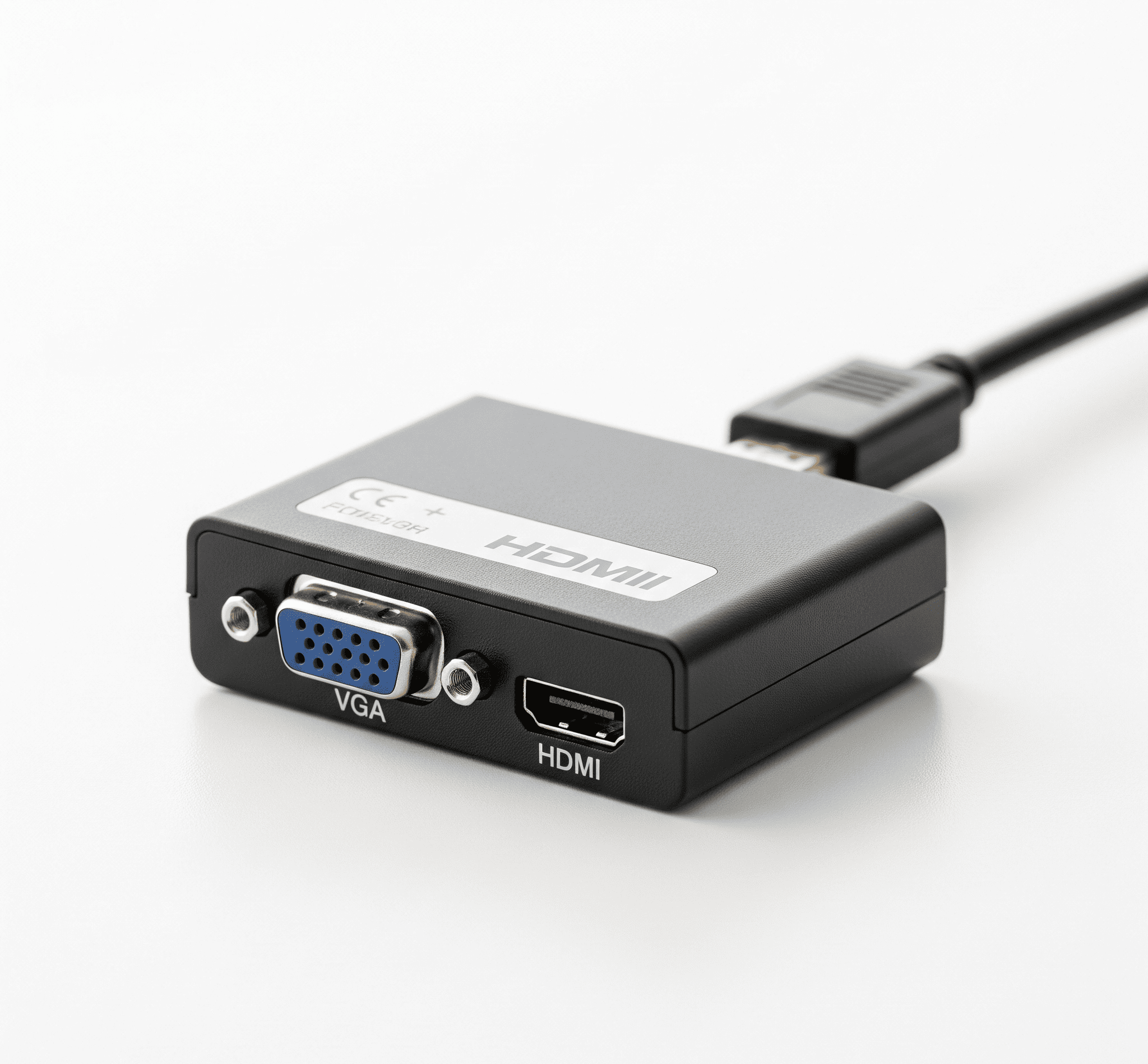Kingsgrove Branch:
VGA to HDMI

VGA to HDMI: Transforming outdated visuals into a vibrant, modern experience. Ever found yourself staring at a screen, wishing its colors were more vivid, its clarity sharper? This guide delves into the world of VGA to HDMI conversion, explaining the why, how, and what to look for when upgrading your visual output. From understanding the differences between VGA and HDMI to choosing the perfect converter, we'll equip you with the knowledge to make the best decision for your needs
VGA signals, while standard, are often incompatible with modern displays. HDMI, on the other hand, is the industry standard for high-definition video and audio. This conversion process allows you to seamlessly integrate older VGA-based devices with the latest HDMI displays, giving you a smoother, more up-to-date visual experience
VGA to HDMI Conversion: A Comprehensive Guide
Connecting older VGA devices to modern HDMI displays can sometimes feel like a puzzle. This guide walks you through everything you need to know about VGA to HDMI conversion, from understanding the basics to troubleshooting common issues. We'll explore different converter types, factors to consider when choosing one, and practical applications. Get ready to bridge the gap between legacy and current technology
Introduction to VGA to HDMI Conversion
VGA (Video Graphics Array) and HDMI (High-Definition Multimedia Interface) are both video standards, but they differ significantly. VGA primarily transmits video signals, while HDMI transmits both video and audio. This fundamental difference leads to the need for converters when adapting older VGA equipment to newer HDMI displays
- VGA, a legacy standard, is excellent for displaying text and graphics, but its resolution and audio capabilities are limited
- HDMI, a modern standard, delivers high-quality video and multi-channel audio. It supports a wide range of resolutions and refresh rates, making it ideal for modern displays
VGA to HDMI converters bridge this gap, allowing you to connect VGA-equipped devices like older computers or projectors to displays that only have HDMI inputs. This conversion is essential for maintaining compatibility in diverse environments, from home offices to classrooms, see USB to HDMI
| Specification | VGA | HDMI |
| Resolution | Up to 1920 x 1200 | Up to 4K and beyond |
| Refresh Rate | Typically 60Hz | Variable, up to 120Hz+ |
| Audio Support | No | Yes, multi-channel |
Types of VGA to HDMI Converters
Various converter types cater to different needs and budgets. Factors like resolution support and additional features can influence the choice
- Basic Converters: These are budget-friendly options often suitable for simple connections. They typically offer a good balance of price and functionality
- Advanced Converters: These offer enhanced features like higher resolutions, better audio support, and improved compatibility with specific devices
- High-End Converters: Designed for professional use or applications requiring superior quality and high-resolution output. They often come with advanced features and robust construction
| Converter Type | Input Resolution | Output Resolution | Supported Features |
| Basic | 1024x768 | 1080p | Basic video output |
| Advanced | 1920x1080 | 4K | High-resolution output, audio support |
Choosing the Right Converter, Vga to hdmi
Several factors need consideration when selecting a VGA to HDMI converter. Your budget, the intended use, and the specific requirements of your setup are crucial
- Resolution and Refresh Rate: Ensure the converter supports the resolution and refresh rate of your source device and display
- Compatibility: Check the compatibility of the converter with your specific VGA source and HDMI display
- Brand Reputation: Opt for reputable brands with a history of reliable products
Using VGA to HDMI Converters
Connecting a VGA source to an HDMI display with a converter is straightforward. Follow these steps carefully
- Connect the VGA cable to the VGA input of the converter
- Connect the HDMI cable to the HDMI output of the converter
- Connect the HDMI cable to the HDMI input of the display
- Turn on both the source device and the display
| Step | Action |
| 1 | Connect VGA cable to converter input |
| 2 | Connect HDMI cable to converter output |
| 3 | Connect HDMI cable to display input |
Compatibility and Performance Considerations
Compatibility issues can arise if the converter or the devices aren't compatible. Thoroughly researching the specifications is vital
- Resolution Mismatch: If the source resolution is higher than the converter's capability, you may encounter image degradation
- Refresh Rate Issues: Using a converter that doesn't support the refresh rate of your display can cause visual artifacts
Utilizing Schnapps.com.au Products for HDMI Output
Schnapps.com.au offers a variety of HDMI products. They provide a wide range of cables and adaptors to cater to different needs
- HDMI Cables: Different lengths and quality levels are available
- HDMI Adapters: These allow for connections with various HDMI and other connector types
Applications and Use Cases
VGA to HDMI converters find use in various scenarios, such as connecting older computers to modern TVs or projectors
- Home Theatre Setup: Connecting older gaming consoles or computers to modern TVs
- Educational Settings: Displaying presentations or educational materials on larger displays
Troubleshooting Common Issues
Q: My image is distorted. What should I do?
A: Check the connections. Ensure that the cables are securely plugged in. Also, verify the resolution and refresh rate settings on both the source and display devices match
Last Point
In conclusion, transitioning from VGA to HDMI opens up a world of enhanced visuals and a more streamlined digital experience. This guide has provided a comprehensive overview of the conversion process, from choosing the right converter to troubleshooting potential issues. With the right knowledge, you can confidently upgrade your setup and enjoy a superior visual experience. Remember to consider your specific needs and budget when making your purchase
Happy viewing!
FAQ Overview
What are the common problems when using VGA to HDMI converters?
Signal loss, image distortion, and lack of audio output are common issues. Troubleshooting these often involves checking connections, adjusting settings, or verifying compatibility
How do I choose the right VGA to HDMI converter?
Consider factors like resolution compatibility, supported refresh rates, and the quality of the converter itself. Read reviews and compare models to find the best fit for your needs
Can I use a VGA to HDMI converter with any VGA source and HDMI display?
Compatibility varies. Check the specifications of your VGA source, HDMI display, and converter to ensure compatibility before making a purchase
What are the potential downsides of using a VGA to HDMI converter?
Potential resolution or quality degradation can occur, and it's essential to consider the refresh rate of your source and display. Sometimes, you might encounter compatibility issues
Recent posts

Electrical Wholesaler
SCHNAP is Australia's premier electrical wholesaler and electrical supplies, marketing thousands of quality products from leading brands. Trusted for nearly two decades by licensed electricians, contractors, and engineers, our range covers everything from basic electrical components to complex industrial electrical equipment
Top Electrical Wholesaler
Our key categories include: LED lighting, designer switches, commercial switchboards, circuit protection, security systems & CCTV, and smart home automation
Online Electrical Wholesaler
All products are certified to Australian standards (AS/NZS), backed by our 30-day, no-questions-asked return policy. Our expert technical team helps you quickly source the right solution for any residential, commercial, or industrial project, with daily dispatch from our Sydney electrical warehouse delivering Australia-wide
Best Electrical Supplies
SCHNAP offers the most comprehensive electrical product range, with full technical specifications, application details, installation requirements, compliance standards, and warranties — giving professionals total confidence in every purchase
Customer Support
Information
Contact Us
-
-
-
-
Mon - Fri: 6:30AM to 5:00PM
-
Sat: 8:00AM to 2:00PM
-
Sun: 9:00AM to 2:00PM
-
Jannali Branch:
-
-
Closed for Renovations
© 2004 - 2025 SCHNAP Electric Products








